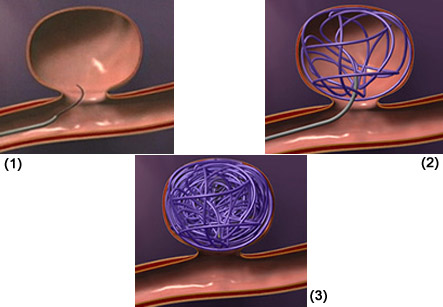Coiling of Aneurysms
Introduction
A brain aneurysm is a balloon-like swelling arising from a weakness in the wall of one of the blood vessels supplying blood to the brain. The concern about the aneurysms is that it can rupture (burst) suddenly and cause severe hemorrhage (bleed).
Coiling treatment was introduced initially as a method of treating ruptured and unruptured aneurysms without the need for a craniotomy (opening the skull to expose the brain). Coiling involves approaching the aneurysm from inside the blood vessel, and not by opening the skull. Small metal coils are inserted into the aneurysm through the arteries that run from the groin to the brain. The coils remain in the aneurysm and prevent blood flowing into the aneurysm. This reduces the risk of a bleed or a re-bleed. Blood then clots around the coils sealing off the weakened area.
Preparation:
The coiling procedure is similar to an angiogram (an X-ray test to take pictures of the blood vessels). It involves insertion of a very small tube (catheter) up to the brain via blood vessels from the groin.
Iran has made significant progress in neurosurgery and The world renowned Iranian scientist in neurological surgery Professor Majid Samii has garnered the 2014 Golden Neuron Award. We have all the information you need about public and private clinics and hospitals that provide Neurosurgical surgeries in Iran, Islamic Republic Of with the best quality and lowest possible price

However, it is much more complex than it appears and is usually carried out under a general anaesthesia in the radiology department.
Patient should not eat or drink anything for about four to six hours before the procedure. .
A small area of the groin may be shaved at the entry site through which the coils will be passed.
On arrival at the radiology department, the patient sign a consent form for giving permission for the surgery. An anesthetist will give general anesthesia, which means the patient will be asleep and feels no pain throughout the procedure.
Procedure:
After the general anesthesia takes effect, the radiologist will make a small incision in the groin through which a catheter will be inserted into the femoral artery. This catheter is then guided through other blood vessels in the body until it reaches the neck and then the brain.
Using a guide wire, the coils are slowly inserted into the aneurysm cavity. The coils are made of platinum, are twice the width of a human hair, and can be of variable length. The number of coils needed depends on the size of the aneurysm. The largest coil is inserted first and then smaller coils are inserted until the aneurysm is filled completely.
A small quantity of electric current is passed through the coil to detach it from the guide wire. This small current also helps the blood to clot and also to seal the aneurysm.
The catheter is then removed. Coiling is a complex and delicate procedure that will take at least three hours or more.
After the procedure:
After the general anesthesia wears off, patient often spends at least two hours in an intensive care unit. During this time, regular neurological observations will be performed by the doctors. It involves asking simple questions, testing the strength of the arms and legs, and shining a light in the eyes. Blood pressure, heart rate, respiratory rate, and oxygen levels are also continuously monitored.
The results show promise for the coiling as a treatment for ruptured aneurysms, both in terms of survival and in the reduction of long-term disability of the patients.
The nurse will check the wound in the groin for any bleeding. The opening in the groin artery is sometimes plugged closed after the procedure, with a device called an angioseal.
Patient will have to lie flat, or at an angle of no more than 30 degrees, for at least six hours after the procedure. This helps with the blood pressure and prevents any excess pressure on the artery which can lead to bleeding at the puncture site in the groin.
Depending on the recovery after this time, the patient may be able to sit up gradually.
Pain-relievers will be given for any discomfort or headaches the patient might be experiencing. Patient is also likely to have a drip to prevent dehydration, and possibly a urinary catheter.
As patient is restricted to bed, pressure stockings are given to wear for preventing blood clots forming in the legs (deep vein thrombosis).
Risks:
As with any invasive procedure, there are certain risks associated with coiling. Possible complications include:
1. Stroke-like symptoms such as weakness or numbness in an arm or leg, slurring of speech, or problems with vision.
2. Bleeding
3. Infection
4. Arterial damage at the catheter insertion site
Results:
Research is still being conducted to explore the benefits and risks of coiling. Initial studies showed that the long-term risks of further bleeding are low for the coiling procedure. The results show promise for the coiling as a treatment for ruptured aneurysms, both in terms of survival and in the reduction of long-term disability of the patients.